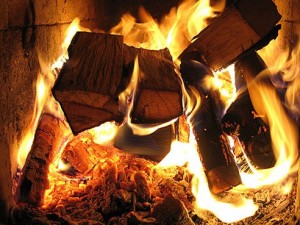Is your neighbour's wood stove pollution affecting you? If so, you might be exposed to a very toxic mix of chemical pollution. Wood burning releases a broad range of indoor air pollution and is a severe trigger for allergy symptoms. We put together the most important questions and their answers in regard to everything you need to know about wood burning and wood stove pollution, and the effects it can have on your health.
What chemicals are found in wood stove pollution?
The combustion (burning) of wood produces around 200 different chemicals including:
- Carbon monoxide
- Nitrogen dioxide
- Heavy metals
- Formaldehyde
- Dioxin
- Benzene
- Toluene
- Fine particles (size ranging from 0.15 to 0.4 microns)
Wood is a natural renewable product, so why does wood stove pollution consist of so many 'bad' chemicals?
Combustion is combustion! It doesn't matter what is being burned – tobacco, petrol, coal or wood – the reaction of air with fuel to give heat and light produces a complex mixture of chemicals, many of which are very harmful to health. Wood stove pollution is always unhealthy.
How does exposure to wood stove pollution compare with cigarette smoke?
It's hard to compare – but the United States Environmental Protection Agency (EPA) said that a badly-ventilated wood burning stove may expose those nearby to as much pollution as smoking between 4 and 16 cigarettes per day. If your neighbour is burning wood, it might be that you are being exposed to even more excessive amounts of airborne pollution.
How far does wood stove pollution spread?
Wood burning stoves contribute a large proportion of all PM outdoor pollution in some localities. It's been claimed that the largest single source of outdoor PM2.5s entering the home in many cities comes from a neighbour's fireplace or wood stove. So you don't even have to own a wood burning stove to be affected by its pollution.
Dr Wayne Ott, believes that only a few hours of wood burning in a single home at night can raise particle concentrations in dozens of neighbouring houses and send Polyaromatic Hydrocarbon (PAH) levels higher than 2000 ng/cubic metre. Many PAHs are defined as carcinogens and any level of exposure may be a threat to health. Another study showed that where wood is the main house heating fuel, wood burning stoves may contribute as much as 80% of the ambient PM10 concentrations during the winter.
What are the health effects of exposure to wood stove pollution?
The World Health Organization estimates that there are 2.7 to 3 million premature deaths per annum from exposure to wood stove pollution. In communities where wood is the main fuel, children are more likely to have reduced lung capacity, more asthma attacks, more respiratory illness in general, and more absence from school.
Meanwhile, the EPA estimates that the lifetime cancer risk from wood smoke is as much as 12 times that from an equal volume of second-hand tobacco smoke. Free radicals (reactive groups of atoms that damage cells and DNA) from wood smoke remain active for 20 minutes, while those from tobacco smoke only stay active for 30 seconds – so the former has more chance of doing damage to our bodies. Wood burning stoves also appear to increase the risk of cancer of the mouth and throat, according to a study carried out in Brazil.
How can I minimise wood stove pollution?
There are several things you can do to limit your exposure to wood stove pollution, including:
- Have your fireplace well constructed in the first place, so it has a good draught to carry the smoke away.
- Make sure there are good doors in front of the fireplace to protect you from pollution.
- Always burn natural wood – not rubbish or wood that has been treated. Use dry, not damp, wood.
- Smaller pieces of wood are better to burn than larger pieces.
- Use a high-quality air purifier in affected areas. The key will be for the air purifier to filter out particulates as well as gases. Visit our air purifier information page to find out more.
How should I maintain a wood burning stove?
You should have your stove, chimney and vent cleaned and inspected once a year by a professional.
What kind of air purifier will protect me from wood stove pollution?
Models like the IQAir MultiGas air purifier are able to remove both the gas and particulate components of pollution from wood-burning stoves. Tests have shown that a proper HEPA air purifier will mitigate the adverse health effects of exposure. A study from British Columbia showed that using an air purifier in homes where a wood burning stove was used did reduce levels of PM2.5, as well as reduce levels of biochemical markers of heart disease in inhabitants of these homes.




